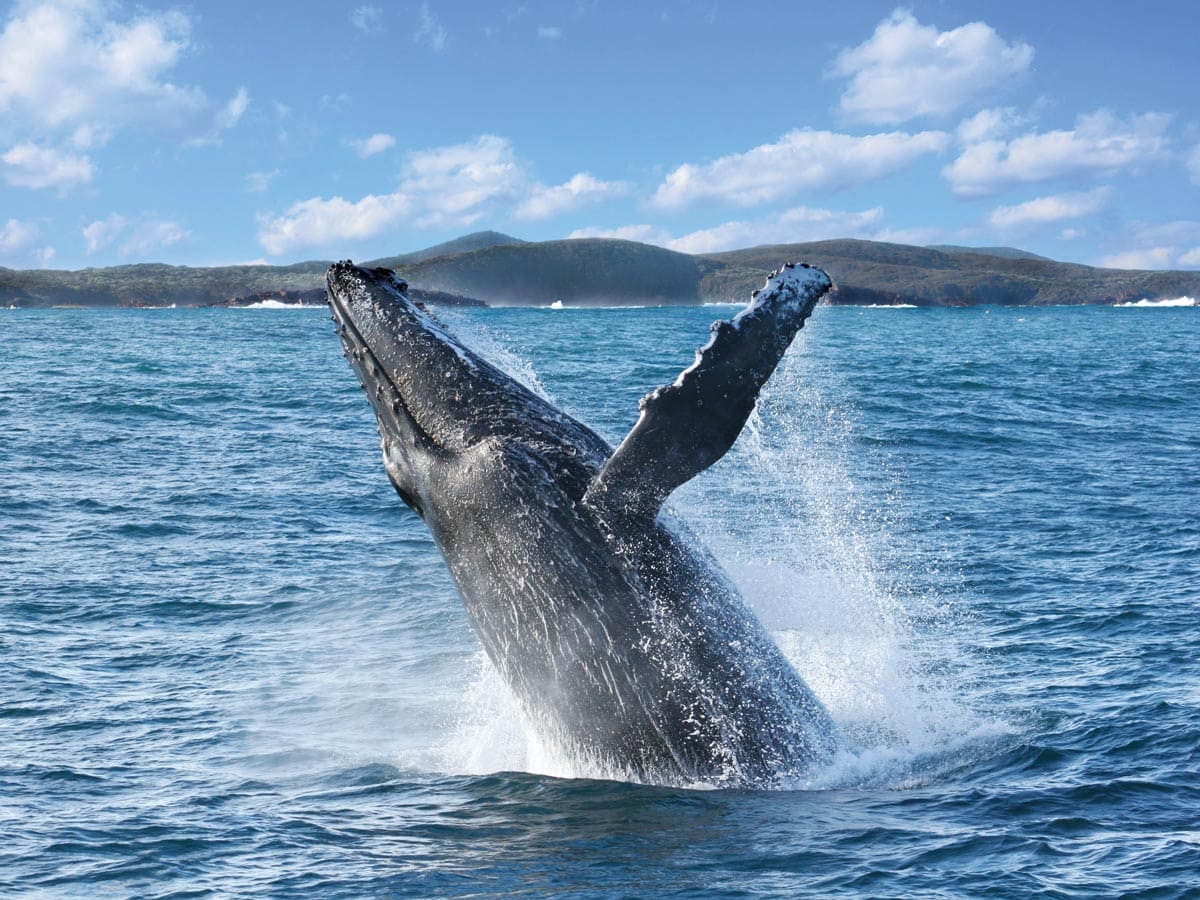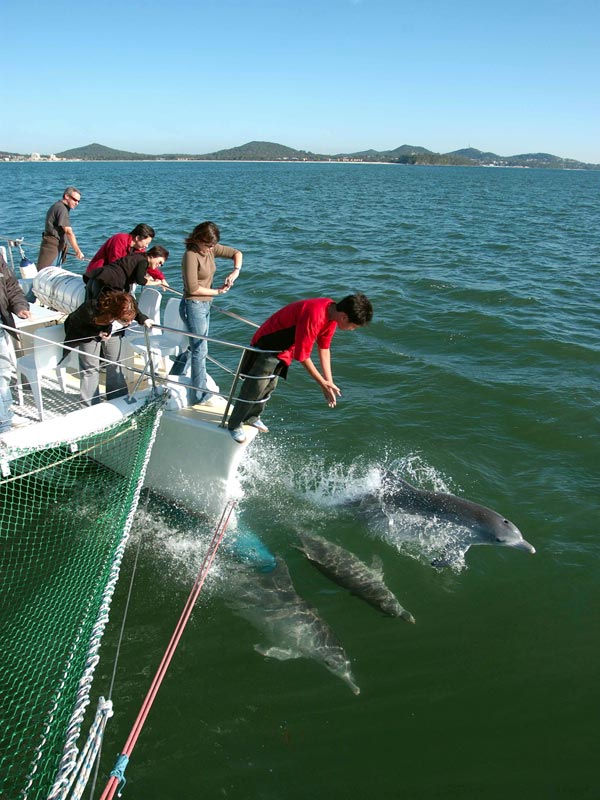16 February 2023
![]() 6 mins Read
6 mins Read

Port Stephens is an aquatic wonderland, home to the Great Lakes Marine Park whose waters are thriving with marine life including hundreds of bottlenose dolphins who are often seen playfully frolicking in the local waters, sea turtles and more than 200 species of fish.

Port Stephens is home to observing dolphins in the wild. (Image: The Legendary Pacific Coast)
Each year, it also becomes a temporary thoroughfare – known as the Humpback Highway – as whales make the great migration north, providing visitors with many excellent opportunities to spot these majestic mammals. Here is the ultimate guide to Port Stephens whale watching.

Discover the splendid marine life of Port Stephens. (Image: Destination NSW)
Every year, tens of thousands of humpback whales leave Antarctica and begin an epic journey of up to 10,000 kilometres along the east coast to the warmer waters of northern Australia. They mate and calve there, before returning along the same route towards the Southern Ocean. Port Stephens whale watching is usually best between June to August and September to October.

Discover majestic whales on your next holiday to Port Stephens. (Image: Destination NSW)
Spotting whales in Port Stephens is easy and can be done either from land or sea. You can join a whale watching cruise from d’Albora Marina, right in the heart of Nelson Bay (see below for more information), or you can head to one of the many Port Stephens lookouts for panoramic ocean views.

Hop on a boat and cruise your way to one of Port Stephen’s best spots to witness amazing marine life with your own eyes. (Image: Destination NSW)
Some of the best whale watching spots in Port Stephens include Tomaree Head Summit, located in Tomaree National Park.

Keep your eyes peeled for whales at Tomaree Head in Port Stephens. (Image: Jarryd Salem)
Take the short but Tomaree Head Summit Walk, which can take between one-and-a-half to two hours return. Follow the track through bushland dotted with gums, grass trees and banksia (you may even see koalas if you’re lucky). At the top, panoramic views across Port Stephens and the ocean are well worth the effort, and it’s an excellent vantage point to spot a pod of whales.

The Tomaree Head Summit Walk offers rewarding views of the ocean. (Image: Destination NSW)
Humpbacks can also be seen from Barry Park, which has a specially built whale watching platform, at Fingal Bay Beach. Fingal Bay is also home to an 1862-built lighthouse, which is only accessible by boat.

Fingal Bay and its paradisaic beach are a must-see when visiting Port Stephens. (Image: Destination NSW)
Drive to Boat Harbour headland on Noamunga Street, just 15 minutes’ drive from Nelson Bay, and take the easy walk to Boat Harbour Whale Watching Lookout, following the signs from the car park.
Birubi Beach in Anna Bay is another great whale watching spot; grab a coffee from Crest Birubi Beach at the surf club and keep your eyes peeled for humpbacks off the beach.

Spend some time in Anna Bay and get down to Birubi Beach to spot some whales. (Image: Destination NSW)
Pack some lunch and head to Iris Moore picnic area in Fishermans Bay. This grassed area has sweeping views of Birubi Beach and Worimi Conservation Lands and is a comfy spot to settle in for whale watching.
You can spot whales any time of the day, but calmer conditions – often early in the morning before winds and waves increase – is usually best so they are easier to see.

Watch whales throughout the day in Port Stephens. (Image: Moonshadow TQC Cruises)
Sunrise and sunset are also good times because this is said to be when they are most active, breaching and slapping their pectoral fins for show; the soft light also provides a beautiful backdrop for photography.

Get up early for sunrise or stay up for sunset for your chance to see whales, and get your camera out to take your best shot. A win-win. (Image: Destination NSW)
Of course, spotting whales is never guaranteed, and conditions are always dependent on the weather.
Departing from d’Alboro Marina, these Nelson Bay whale watching cruises make spotting whales easy.
Moonshadow – TCQ Cruises has been running cruises for more than 40 years and has seven different vessels for whale watching, dolphin watching, historical cruises, dinner cruises and more.

Cruises are the perfect opportunity for whale watching. (Image: Moonshadow TQC Cruises)
Departing daily from Nelson Bay, the whale watching cruises run for two-and-a-half to three hours between May and November. There is a fully licensed bar onboard for snacks and drinks.

Get close to whales in Nelson Bay. (Image: Moonshadow TQC Cruises)
Another long-running cruise operator is ecotourism Imagine Cruises, which offers whale watching, dolphin watching, snorkelling, eco walks, dinner cruises and more. It runs daily 90-minute express whale watching cruise on board a 40-foot power cat run by AquaMarine Adventures, as well as a daily three-hour-plus whale and dolphin watching cruise on a 53-foot catamaran.

In Nelson Bay, you can also spot dolphins. (Image: Imagine Cruises)
If you’d prefer a private whale watching charter, where you don’t have to hustle for a good view of a whale breaching, check out Blue Water Sailing. It has luxury yachts available for a three-hour cruise for up to six people.
Because whale watching occurs over the winter months, you’ll need to wear warm clothes.
Consider packing a wind jacket, as it can get windy out on the ocean, and a waterproof jacket is a good idea in case of wet weather or ocean spray.
Pack a hat and sunscreen, as even during winter the sun can burn, especially when reflecting off the water.
Take binoculars with you, especially if you’re trying to spot whales from the land.
If you’re heading out on a boat, and you’re prone to sea sickness, prepare yourself by taking sea sickness tablets and taking a sick bag (though many cruise operators will have these on board in case of the unfortunate event that you do get sick!).
If you’re heading up to Tomaree Head Summit, be sure to wear some good walking shoes.
LEAVE YOUR COMMENT